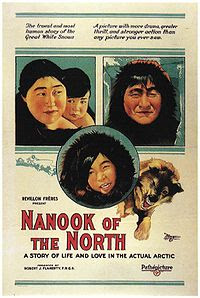
Filmmaker Robert Flaherty spent some years traveling the far points of the earth -- mining, mapping, and exploring -- and took up an interest in film while on an expedition for Sir William Mackenzie's Canadian railroad. Original footage capturing Inuit life in the harsh Hudson Bay regions in Canada were destroyed in a fire upon Flaherty’s return home, but only after enjoying a wildly enthusiastic response from those who saw it. He returned to the far north with the sole purpose of filming in mind -- Nanook of the North is widely considered the first documentary film made, and Flaherty is considered a progenitor of “ethnographic film.”
This is a short, silent (black and white, need we say it?) movie that even your bounciest of kids may be able to sit through, as one scene after another is a jaw-dropping delight. Witnessing the patience and stealth needed to ice fish, to kill a monstrous, blubbery walrus, or to carefully construct an air-tight igloo (the window remodel scene was just the most awesome thing!), is mind boggling, and what’s better than visuals that happen to be fascinating and educational at the same time?
Husband D and I were so glad we saw this, even though we had to wrangle an increasingly impatient, pre-teen K into sitting through it. But we marveled over scenes, wondering how much was staged, and how much was natural.
I’m not going to spoil it by telling them that, according to Wikipedia, much of it was staged (some forgivably and necessarily, considering the restraints of filmmaking equipment at the time). Flaherty also wanted to show the historical, traditional ways of life in the far north, so, for example, although the Inuit at the time were using firearms for hunting they put them aside for the film. Nanook’s wife was not really his wife, but an actress.
Harder to take, according to Wikipedia (however, a “citation needed” notation appears next to this tidbit), is that Flaherty may have put Nanook and others in jeopardy all in the name of a few good shots. The worst of it is a detail credited on Wikipedia to Melanie McGrath's book, The Long Exile: A Tale of Inuit Betrayal and Survival in the High Arctic: Flaherty reportedly had an affair with the woman playing Nanook’s wife, and fathered a son that he never owned up to.
There is absolutely no mention of this on IMDB, so perhaps Wikipedia’s claims and sources are incorrect. I like to think that’s possible.
All that aside, this film was one of the first 25 films to be selected in 1989 for preservation in the United States National Film Registry by the Library of Congress as being "culturally, historically, or aesthetically significant.” Forgiving the manipulation Flaherty may have felt necessary at the time to get his point across, one can certainly applaud the Film Registry’s effort, and enjoy this film simply for its purpose and spirit, and the truths that lie in it, even if they are perhaps slightly distorted. Flaherty had real foresight and vision; he also had an abundance of resourcefulness and creativity, and he possessed an admirable adventurousness, to say the least.
(There is a 1994 film depicting Flaherty’s making of Nanook, called Kabloonak [it means, “stranger], and one reviewer on IMDB calls it “A work of Existential art.” It might be worth checking out.)












No comments:
Post a Comment
Leave a comment here for KidsFlix!